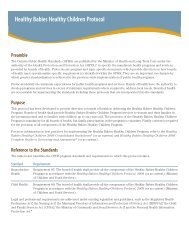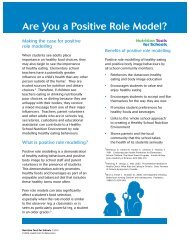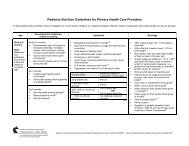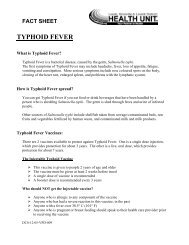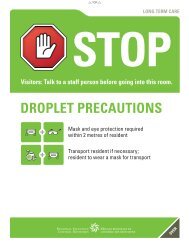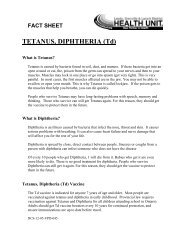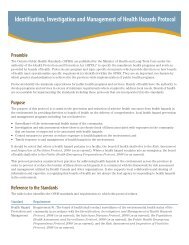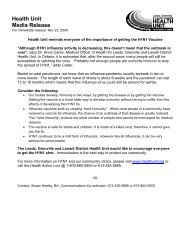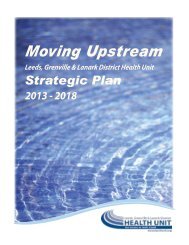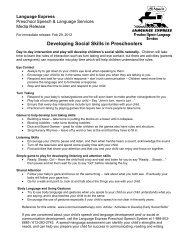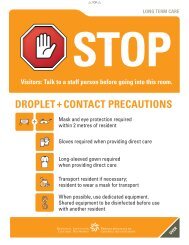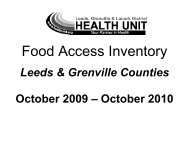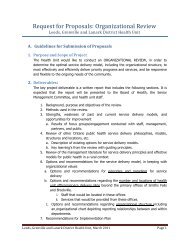Red Flags â - Leeds, Grenville and Lanark District Health Unit
Red Flags â - Leeds, Grenville and Lanark District Health Unit
Red Flags â - Leeds, Grenville and Lanark District Health Unit
You also want an ePaper? Increase the reach of your titles
YUMPU automatically turns print PDFs into web optimized ePapers that Google loves.
ABUSE<br />
PHYSICAL ABUSE<br />
Physical abuse is any deliberate physical force or<br />
action (usually by a parent, guardian or caregiver)<br />
that results, or could result, in injury to a child.<br />
Physical abuse is also any harm to a child caused<br />
by an action or omission of action. It is different<br />
from what is considered reasonable discipline. It<br />
can include punching, slapping, beating, shaking,<br />
burning, biting or throwing a child. Injuries may<br />
include bruises, welts, cuts, fractures, burns, or<br />
internal injuries. Physical abuse can be one or two<br />
isolated incidents or can occur over a prolonged<br />
period of time.<br />
The signs <strong>and</strong> indicators of abuse <strong>and</strong> neglect may<br />
include but are not limited to those that follow. It<br />
is important to realize that the presence of any one<br />
indicator is not conclusive proof that a child has<br />
been abused. In most instances, abused children<br />
will exhibit a number of behavioural <strong>and</strong> physical<br />
indicators.<br />
Physical indicators in children<br />
►► Injuries that are not consistent with explanation<br />
►► Presence of several injuries that are in various<br />
stages of healing<br />
►► Presence of various injuries over a period of time<br />
►► Facial injuries in infants <strong>and</strong> preschool children<br />
►► Injuries inconsistent with the child’s age <strong>and</strong><br />
developmental phase<br />
►► A lot of bruises in the same area of the body<br />
►► Bruises in the shape of an object, e.g., spoon,<br />
h<strong>and</strong>/fingerprints, belt<br />
►► Burns:<br />
□□ from a cigarette<br />
□□ in a pattern that looks like an object, e.g., iron<br />
□□ wears clothes to cover up injury, even in<br />
warm weather<br />
►► Patches of hair missing<br />
►► Signs of possible head injury:<br />
□□ swelling <strong>and</strong> pain<br />
□□ nausea or vomiting<br />
□□ feeling dizzy<br />
□□ bleeding from the scalp or nose<br />
►► Signs of possible injury to arms <strong>and</strong> legs:<br />
□□ pain<br />
□□ sensitive to touch<br />
□□ cannot move properly<br />
□□ limping<br />
►► Breathing causes pain<br />
►► Difficulty raising arms<br />
►► Human bite marks<br />
►► Cuts <strong>and</strong> scrapes inconsistent with normal play<br />
►► Signs of female genital mutilation, e.g., trouble<br />
going to the bathroom<br />
Behavioural indicators in children<br />
►► Cannot remember how injuries happened<br />
►► The story of what happened does not match the<br />
injury<br />
►► Refuses or is afraid to talk about injuries<br />
►► Is afraid of adults or of a particular person<br />
►► Does not want to be touched<br />
►► May be very:<br />
□□ aggressive<br />
□□ unhappy<br />
□□ withdrawn<br />
□□ obedient <strong>and</strong> wanting to please<br />
□□ uncooperative<br />
►► Is afraid to go home<br />
►► Runs away<br />
►► Is away a lot <strong>and</strong> when comes back there are<br />
signs of healing injury<br />
►► Does not meet developmental milestones as<br />
expected<br />
►► Does not get along well with other children<br />
►► Tries to hurt himself, e.g., cutting himself, suicide<br />
►► Discloses abuse<br />
Behaviours observed in adults who abuse children<br />
►► Does not tell the same story as the child about<br />
how the injury happened<br />
►► May say that the child seems to have a lot of<br />
accidents<br />
►► Severely punishes the child<br />
►► Cannot control anger <strong>and</strong> frustration<br />
►► Expects too much from the child<br />
►► Talks about having problems dealing with the<br />
child<br />
►► Talks about the child as being bad, different, or<br />
“the cause of my problems”<br />
►► Shows no affection toward the child<br />
►► Does not go to the doctor right away to have<br />
injury checked<br />
►► Has little or no help caring for the child<br />
28 <strong>Red</strong> <strong>Flags</strong>: Early Identification in <strong>Leeds</strong>, <strong>Grenville</strong> & <strong>Lanark</strong> November 2007



